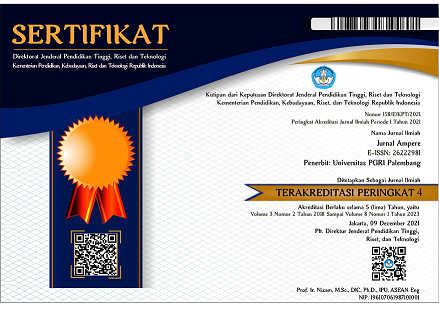MESIN PENIRIS KRIPIK BERBASIS MOTOR LISTRIK TIGA FASA DAN MIKROKONTROLER ADRINO UNO
DOI:
https://doi.org/10.31851/ampere.v4i2.3448Keywords:
chips dryer, electric motors, Arduino Uno, inverterAbstract
Chips are a typical Indonesian snack that is widely favored by the entire community. In the process of making chips it takes the oil drying stage. The purpose of drying oil is to remove the oil content in the chips so that the chips are not rancid. The conventional method commonly used to remove the oil content is by placing the chips  on paper. The paper functions to absorb the oil on the chips. In this paper an electric motor-based chips drying machine will be delivered. This machine is built on an induction motor as a driver, an inverter as a speed regulator, and an Arduino Uno microcontroller as a sensor controller. The method of making uses experimental design. This machine will stop automatically when the chips are dry. Three types of chips have been successfully dried with this machine.
Abstrak— Keripik merupakan makanan ringan khas indonesia yang banyak digemari oleh seluruh masyarakat. Dalam proses pembuatan keripik dibutuhkan tahap pengeringan minyak. Tujuan pengeringan minyak adalah untuk menghilangkan kandungan minyak yang ada pada kripik tersebut agar kripiknya tidak  tengik. Metode konvensional yang biasa digunakan untuk mengeluarkan kandungan minyak tersebut adalah dengan meletakkan kripik yang dikeringkan pada kertas. Kertas berfungsi menyerap minyak yang pada keripik tersebut. Pada makalah ini akan disampaikan sebuah mesin pengering keripik berbasis motor listrik. Mesin ini dibangun atas motor induksi sebagai pengerak, inverter sebagai pengatur kecepatan , dan mikrokontroler arduino uno sebagai pengendali sensor. Metode pembuatan menggunakan desain eksperimen. Mesin ini akan berhenti secara otomatis apabila keripik sudah kering. Tiga jenis kripik sudah berhasil dikeringkan dengan mesin ini.
Â
Kata kunci: peniris kripik, motor listrik, arduino uno, inverter
References
. Hamimi, H., Tamrin, T. and Setyani, S., 2012. Uji Kinerja Mesin Peniris Minyak Goreng Pada Pengolahan Keripik. Jurnal Teknologi & Industri Hasil Pertanian, 16(1), pp.91-10.
. Sugandi, W.K., Kramadibrata, A.M., Fetriyuna, F. and Prabowo, Y., 2018. Analisis Teknik dan Uji Kinerja Mesin Peniris Minyak (Spinner)(Technical Analysis and Test Performance of Oil Spinner Machine). Jurnal Ilmiah Rekayasa Pertanian dan Biosistem, 6(1), pp.17-26.
. Prasidya, G. 2018. Mesin peniris keripik goreng berbasis motor listrik dan mikrokontroler (Skripsi, Universitas Katolik Widya Mandala Surabaya), diakses 20 Januari 2019).
. Kurniawan, A. and Harumwidiah, A., 2015. Strategi Kendali Kecepatan Motor Induksi Menggunakan PWM Inverter Berbasis Jaringan Saraf Tiruan. Transmisi, 17(2), pp.83-88.
. Syofian, A., 2016. Pengendalian Pintu Pagar Geser Menggunakan Aplikasi Smartphone Android dan Mikrokontroler Arduino Melalui Bluetooth. Jurnal Teknik Elektro-ITP, 5(1).
. Dani, A.W., Adriansyah, A. and Hermawan, D., 2016. Perancangan Aplikasi Voice Command Recognition Berbasis Android dan Arduino Uno. None, 7(1)
. Silvia, A.F., Haritman, E. and Mulyadi, Y., 2014. Rancang Bangun Akses Kontrol Pintu Gerbang Berbasis Arduino Dan Android. Electrans, 13(1), pp.1-1
. Hartono, B.P. and Nurcahyo, E., 2017. Analisis Hemat Energi Pada Inverter Sebagai Pengatur Kecepatan Motor Induksi 3 Fasa. Elektrika: Jurnal Teknik Elektro, 1(1), pp.8-16.
. Kaewmard, N., & Saiyod, S. (2014). Sensor data collection and irrigation control on vegetable crop using smart phone and wireless sensor networks for smart farm. In 2014 IEEE Conference on Wireless Sensors (ICWiSE) (pp. 106-112).
. Saptadi, A.H., Kurnianto, D. and Suyani, S., 2015. Rancang Bangun Thermohygrometer Digital menggunakan Sistem Mikropengendali Arduino Dan Sensor Dht22. Prosiding SNST Fakultas Teknik, 1(1).
. Bogdan, M., 2016;. How to use the DHT22 sensor for measuring temperature and humidity with the arduino board. ACTA Universitatis Cibiniensis, 68(1), pp.22-25
Downloads
Published
How to Cite
Issue
Section
License

Jurnal Ampere is licensed under a Creative Commons Attribution-ShareAlike 4.0 International License.
Authors who publish with this journal agree to the following terms:
- Authors retain copyright and grant the journal right of first publication with the work simultaneously licensed under a Creative Commons Attribution License that allows others to share the work with an acknowledgement of the work's authorship and initial publication in this journal.
- Authors are able to enter into separate, additional contractual arrangements for the non-exclusive distribution of the journal's published version of the work (e.g., post it to an institutional repository or publish it in a book), with an acknowledgement of its initial publication in this journal.
- Authors are permitted and encouraged to post their work online (e.g., in institutional repositories or on their website) prior to and during the submission process, as it can lead to productive exchanges, as well as earlier and greater citation of published work.






